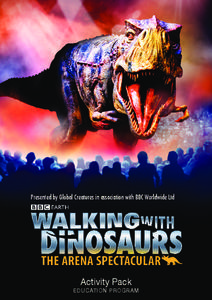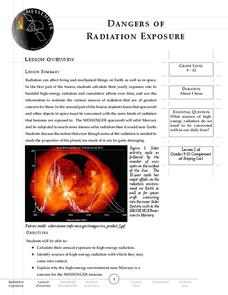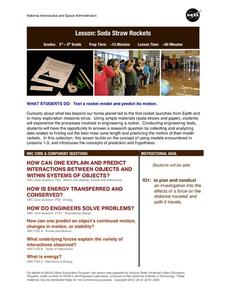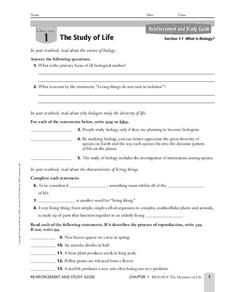Curated OER
Worksheet 3: Earth's Climate System II
A diagram of a mountain range and the prevailing winds is shown at the top of the page. Meteorology pupils describe the weather conditions at different points on the diagram. They explain the El Nino effect and why evaporation and...
K12 Reader
Why Does the Moon Orbit Earth?
Have you ever looked up at the moon and wondered why it looks different every night? Learn about the moon's orbit and the lunar cycle with a reading comprehension exercise. Using context clues, kids find the definitions of unfamiliar...
Curated OER
The Greenhouse Effect
For this Earth Science worksheet, students read about the Greenhouse Effect and the difference between natural and amplified warming. Following, they answer ten short answer questions related to what they read about global climate issues.
Curated OER
Apparent Motion of the Sun
Demonstrate the path of the sun across the sky at different times of the year with an engaging science lesson. Learners use a series of questions and diagrams to examine the movement of the sun and appearance of the sky around...
Rivanna Regional Stormwater Education Partnership
Invisible Passengers
How does water pollution affect the organisms living in the water? Use three science experiments to examine how erosion and other pollutants can affect water quality. Each experiment focuses on a different aspect of pollution and...
Curated OER
Earthquakes-Science Puzzlers, Twisters, & Teasers
In this earth science worksheet, students complete 4 word puzzlers and twisters about earthquakes as well as answer 11 true or false questions.
Curated OER
The Movement of Ocean Water-Science Puzzlers, Twisters & Teasers
In this earth science worksheet, students complete 19 questions about oceans and the movement of ocean water in the form of puzzles, word scrambles, and brain teasers.
Curated OER
The Rock and Fossil Record-Science Puzzlers, Twisters & Teasers
In this earth science worksheet, students complete 12 questions about rocks and fossils in the form of anagrams, riddles, sequences, and brain teasers.
BBC
Walking with Dinosaurs
Breath new life into your class's study of dinosaurs with this extensive collection of materials. Offering everything from a printable T-rex mask, word searches, and connect-the-dots activities to informational handouts, hands-on...
K12 Reader
Where On Earth Are You?
What do we use to determine the exact locations on the earth? Your kids can learn all about compass roses and latitude and longitude. Test understanding with the five reading comprehension questions included on the page.
Messenger Education
Dangers of Radiation Exposure
Gamma radiation, which is harmful, is useful in treating cancers. In the second lesson in a series of four, young scientists take surveys and calculate their yearly exposure to ionizing radiation. Then they read about how harmful their...
Curated OER
Women in Science: Dr. Grace Bush
Learn about the study of paleoecology with a resource about Dr. Grace Bush and her contributions to the field. After reading a one-page passage, learners answer comprehension questions and explore their personal interests in different...
Creative Chemistry
Fossil Fuels Summary
As the title suggests, this is a simple summary of fossil fuels. There are no questions or problems to solve or no notes about fossil fuels. The notes cover how fossil fuels are formed, how we extract them, what humans use them for, and...
NASA
Soda Straw Rockets
Three, two, one, blast off to a better understanding of force and motion with this exciting science lesson! Beginning with a discussion about rockets and gravity, young scientists go on to complete a series of worksheets about net...
Curated OER
Earth's Layers Foldable Questions Sheet
In this earth's layers instructional activity, students answer questions about the main layers of the earth using the model they built in the activity. They write details about each layer and answer questions.
Curated OER
What is Momentum?
In this momentum worksheet, students will calculate the maximum forward momentum of the Apollo 11 lunar spacecraft at three different stages of its space travel.
Curated OER
Science - 'Why does the wind blow?'
In this earth science worksheet, students read a poem about the wind and learn why the wind blows. After reading the poem and informative paragraphs that follow it, students answer 2 questions regarding the information they read....
Curated OER
What is Biology?
In this science of biology worksheet, students will review the concepts relating to biology including the characteristics of living things, the process of reproduction, adaptations, and evolution. This worksheet has 5 short answer, 3...
Curated OER
What is Climate?
For this weather worksheet, middle schoolers read a brief excerpt that compares the various types of climates found on Earth. Then they explain where the low- and high-pressure systems follow each other throughout the year.
Curated OER
What is Magnetism?
In this magnetism worksheet, learners review what magnetism is by matching 5 words to their definitions. Then students use a diagram showing the pattern of iron fillings around magnets to complete 4 short answer questions.
K12 Reader
World Climates
Why is weather different around the world? Learn about world climates with a reading comprehension passage. Kids read a short passage before answering five comprehension questions based on context clues.
US Environmental Protection Agency
Building an Model Aquifer
With almost half of Americans relying on groundwater supplies, it is more important than ever to protect aquifers from possible contaminants. Working in small groups, young environmentalists explore this problem as they create an aquifer...
Canadian Space Agency
The Phases of the Moon
What phase is that moon in? Young astronomers complete a lunar cycle diagram and describe each moon phase below.
Curated OER
The Earth's Layers
In this earth's layers worksheet, students learn about the 3 different layers of the earth: core, mantle and crust. They then use this information to answer the 16 questions in the packet. The answers are all on the last page.























